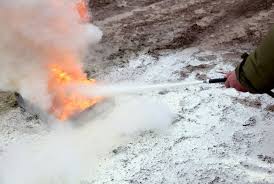How to Clean up After Using a Fire Extinguisher
How to Clean up After Using a Fire Extinguisher. You have had a fire, and have safely used your fire extinguisher to put out the fire. Job well done, but now the cleanup has just begun. Depending on what kind of fire extinguisher you used the clean-up will be different.
How to Clean up After Using a Fire Extinguisher. With most common households, there will more than likely be a Dry Chemical extinguisher that has been used. In all instances, the powder from a fire extinguisher can be an irritant to your lungs, eyes, and throat so make sure to wear a dust mask, gloves, and googles for proper protection.
There are three different bases for a Dry Chemical extinguisher being a silicone, sodium bicarbonate/potassium bicarbonate, and monoammonium phosphate based dry chemicals. Always make sure you know what kind of extinguisher you have in order to properly know how to use it. For each of these the first step is vacuuming or sweeping the affected areas to get up the residue. Whether vacuuming, sweeping or using a cloth to collect the dry chemical, make sure to properly dispose of the dry chemical in a plastic bag and tied it up. This can be thrown in the usual trash cans; no special disposal is required.
For the monoammonium phosphate based dry chemical, to wash down the area a simple solution of hot water and baking soda is used no real ratio is needed just a simple mixture of them will do. Simply apply or spray on to the affected area, then let it sit for a few minutes and simply rinse with warm water.
If the dry chemical is a silicone based then spray the area with a solution that is 50% isopropyl alcohol, and 50% warm water. Spray on top of the affected are and allow this solution to sit for a few minutes and then rinse with warm water.
The sodium bicarbonate, or potassium bicarbonate will require a solution of 98% hot water and 2% vinegar. Spray the affected are and allow to permeate for a few minutes and then rinse with warm water. When spraying the affected area, you want to make sure it is damp not soaked. This will help in releasing the dry chemical and any odors as well.
Now there can be an occasion of having to clean up Wet Chemical from extinguishers as well that have been discharged. These are more for kitchens and their systems, but proper clean-up of these can prevent any harm to expensive equipment as well. First step in this is to make sure any fuel sources or energy sources have been disengaged or shut off. Make sure to wear proper protective gear such as rubber gloves, googles, and masks. Make sure the wet chemical agent does not come in contact with your skin, it is an irritant. Use hot, soapy water and wipe with a sponge or cloth to remove the residue. Make sure no excess of agent is left behind by thoroughly rinsing and allowing time to dry. Only after it is properly dried is it recommended to turn back on the equipment or appliances.
For clean agents, there is no special precautions due to that discharge dissipates into the atmosphere. There are the K Class extinguishers in which any affected area from a discharge of these extinguishers will just need to be rinsed with soap and water immediately after discharge.
Cleaning Up and Removing Smoke Odor
- Products containing tri-sodium phosphate (TSP) can reduce odors in fabrics. TSP is caustic so be careful! Read the label for directions and safety instructions.
- Test garments before using any treatment, and follow the manufacturer’s instructions. Smoke odor and soot can sometimes be washed from clothing that can be bleached. Measure 4 to 6 tbsp. Tri-Sodium Phosphate and 1 cup household cleaner or chlorine bleach for every gallon of warm water you will use. Alternatively, consider washing clothes in cold water with your usual household laundry detergent, and adding one tablespoon of pure vanilla extract.
- To remove soot and smoke from walls, furniture and floors, use a mild soap or detergent or mix together 4 to 6 tbsp. tri-sodium phosphate and 1 cup household cleaner or chlorine bleach to every gallon of warm water. Wear rubber gloves. Be sure to rinse surfaces with clear warm water and dry thoroughly.
- Wash walls one small area at a time, working from the floor up to prevent streaking. Rinse with clear water immediately. Ceilings should be washed last. Do not repaint until walls and ceilings are completely dry. Reduce the chances of growth of mold and mildew by wiping down all surfaces that had gotten wet with a solution of one cup of liquid household bleach to a gallon of water. (Test surfaces to ensure that the bleach solution will not discolor these surfaces. To conduct this test, wipe a small area of the surface with the bleach solution, and allow it to dry at least 24 hours.)
- Washable wallpaper can be cleansed like painted walls, but do not wet through the paper. Use a commercial paste to repaste any loose edges or sections.



